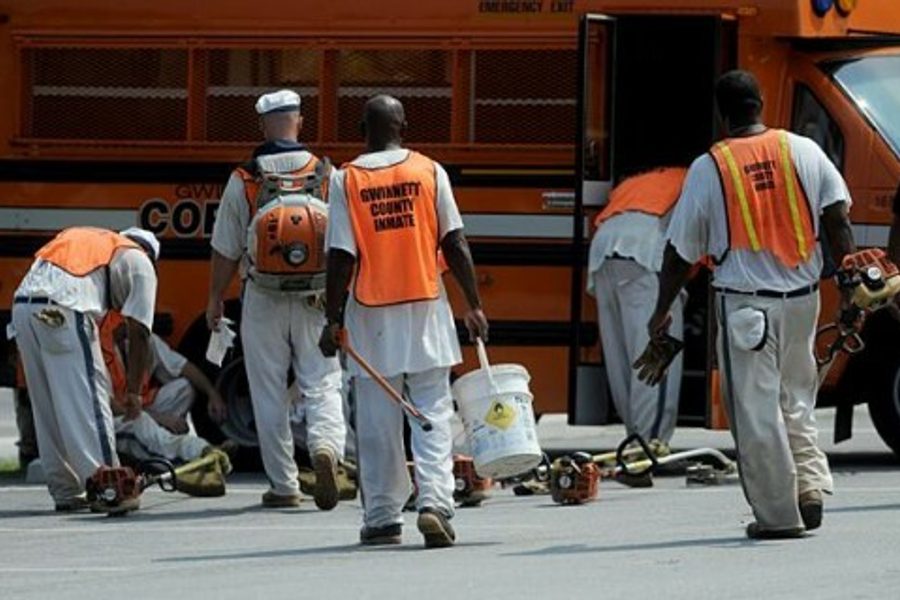
Prison isn’t just about doing hard time. For many, it’s about working full-time, too. These days, state governments seem ready to squeeze their captive workforces to plug budget gaps on the cheap.
From the chain gang to the gulag, labor in the prison population predates our modern labor regulations and to this day, remains relatively untouched by the legal protections afforded to regular workers. So in most states, prison work has come to be seen as a hybrid between conscript labor and rehabilitation, putting otherwise “idle” inmates to work on farms, manufacturing plants, and janitorial jobs.
The New York Times reports that in many areas, laborers in prison uniforms are a growing presence at public work sites, suggesting that they’re being used to alleviate fiscal pressures that are now eroding common public sector services:
[O]fficials are expanding the practice to combat cuts in federal financing and dwindling tax revenue, using prisoners to paint vehicles, clean courthouses, sweep campsites and perform many other services done before the recession by private contractors or government employees.
In New Jersey, inmates on roadkill patrol clean deer carcasses from highways. Georgia inmates tend municipal graveyards. In Ohio, they paint their own cells. In California, prison officials hope to expand existing programs, including one in which wet-suit-clad inmates repair leaky public water tanks. There are no figures on how many prisoners have been enrolled in new or expanded programs nationwide, but experts in criminal justice have taken note of the increase.
As we reported in December, prison labor conditions have sparked some noteworthy revolts. A wave of strikes rocked several prisons in Georgia late last year, touching off a national campaign for the dignified treatment of prison workers.
The uprisings shed light on how vulnerable inmates are when the prison-industrial complex operates not just as a warden and dictator but a boss as well, marshalling the labor of thousands with little oversight. The Georgia inmates drafted a list of grievances ranging from abusive treatment to work without wages.
The inmates’ direct actions resonated with civil rights groups who have pointed out disturbing continuities between the era of slavery and the racialization of imprisonment, and by extension, the industries tied to it. The mass incarceration of black men, and their punitive deployment — explicitly sanctioned under the Constitution—in the dregs of industrial capitalism, speaks loud and clear to the theory of prison as America’s “new Jim Crow.”
Allegations that prison guards severely beat an inmate protester in retaliation underscore the inequality endemic to this labor system, even though the programs are typically endorsed as a form of rehabilitation and self-help.
Of course, today’s prison labor is more regulated and considerably less brutal than the post-Civil War convict-lease system — a regression to slavery disguised as a criminal penalty. (Some reforms were enacted during the Great Depression to prevent downward-spiraling competition between “free labor” and incarcerated workers.)
Yet the institutional parallels are striking. From the late-19th through the early 20th century, southern states, including Georgia, turned to prison labor as a release valve for dealing with fiscal crisis. And the white supremacist power structure, through “leases” with the private sector, enabled forced labor, torture and abuse on a massive scale.
How interesting, then, that in this latest economic crisis, states once again seem to be looking to prison as a resource for carrying out various government services. As an inexpensive “public” labor source, a cash-strapped bureaucracy might see inmates as a convenient alternative to, say, real public workers. Particularly the kind of workers who vote, and who have collective bargaining rights, which tend to get in the way of budget deals.
Is there any way to get around the historically ingrained perverse incentives to exploit prison labor? A budding campaign in Canada could bridge the civil rights debate and the underlying labor struggle. In Vancouver, some prisoners could soon get a full-fledged union, potentially a watershed in protecting both inmates and blue-collar workers, reports the Canadian Press:
Their lawyer, Natalie Dunbar, said Friday organizers at Mountain Institution in Agassiz are trying to sign up members for ConFederation, Canadian Prisoners’ Labour Union, Local 001.
A spokeswoman for the institution said administrators are moving very carefully because no penal institution in Canada has ever been confronted with the issue.
“It’s a new element for us,” assistant warden Brenda Lamm said. “We’ve never had inmates trying to organize a labour union before so that’s why we’re proceeding cautiously and thoughtfully.”
Dunbar said there’s a lack of resources at federal institutions to address issues that plague prison populations as a workforce, such as proper work boots and qualified first-aid personnel.
Such a social experiment probably won’t be attempted in America’s prison-industrial complex, which is one of the world’s largest and deeply embedded with the profit interests of corporations and officials. Unionization alone would never cure the racial disparities and human rights abuses that plague the system.
But these are strange times. Inspired by the Wisconsin standoff, we see new labor solidarity movements popping up across the country, new momentum for public sector labor organizing, and rising political backlash against policies that degrade working people. Maybe the workers taking to the streets have some courage to share with their brothers and sisters trapped behind bars.
Michelle Chen is a contributing writer at In These Times and The Nation, a contributing editor at Dissent and a co-producer of the “Belabored” podcast. She studies history at the CUNY Graduate Center. She tweets at @meeshellchen.








